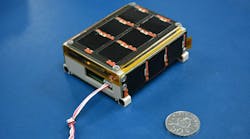As researchers work to build lighter, more powerful satellites, communications payloads must adapt to the new surroundings, which means finding a compliant infrastructure. Engineers at the Satellite Research Centre of Nanyang Technological University in Singapore recently turned to ZigBee, typically only used for land-based wireless systems, as an alternative for satellite communications (SATCOM). In an experiment, the team recently launched VELOX-I, which consisted of a nanosatellite and piggyback picosatellite. Both satellites were configured with a ZigBee wireless sensor network (WSN).
Onboard sensor-node functionality, including local sensing, distributed computing, and data-gathering, support intra-SATCOM. The miniature satellites—weighing 3.5 kg (nanosatellite) and 1.5 kg (picosatellite)—were able to maintain inter-SATCOM with each other over long distances.
Having previously tested the satellites’ range in the laboratory, the team this time applied a link budget analysis based on the Friis transmission equation, to test the range in free space. An average theoretical distance of 4.186 km and a maximum of 15.552 km were derived.
WSNs also proved proficient for intra-satellite communications. The team found that replacing internally wired connections with wireless links could reduce a satellite’s mass by up to 10%. Overall, by essentially eliminating the communications cabling in typical satellites and minimizing development costs and risks, WSNs could lead to a new platform for formation-flying satellite missions.
All findings were published in special issue of World Scientific’s Unmanned Systems.

